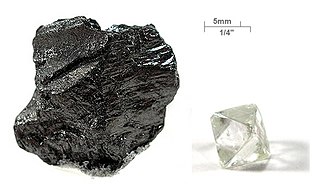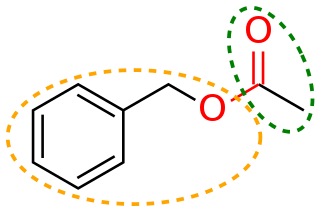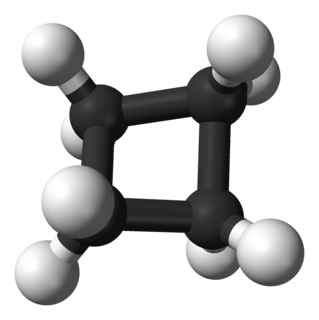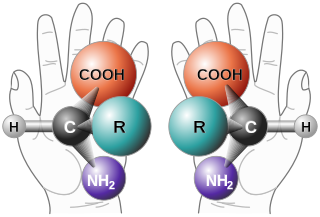This article needs additional citations for verification .(September 2014) |
This is a partial list of molecules that contain 20 carbon atoms.
| Chemical formula | Synonyms | CAS number |
|---|---|---|
| C20F42 | perfluoroicosane | 37589-57-4 |
| C20H6I4Na2O5 | erythrosine | 16423-68-0 |
| C20H12 | perylene | 198-55-0 |
| C20H12 | benz(e)acephenanthrylene | 205-99-2 [1] |
| C20H12O5 | fluorescein | 2321-07-5 |
| C20H13N3O7 | anthracene picric acid | 5937-78-0 |
| C20H14NO4 | sanguinarine | 2447-54-3 |
| C20H14O4 | diphenyl isophthalate | 744-45-6 |
| C20H14O4 | diphenyl terephthalate | 1539-04-4 |
| C20H14O4 | phenolphthalein | 77-09-8 |
| C20H14O4 | resorcinol dibenzoate | 94-01-9 |
| C20H15NS | trityl isothiocyanate | 1726-94-9 |
| C20H16 | triphenylethylene | 50-72-0 |
| C20H16Fe2I3 | biferrocenium triiodide | 39470-17-2 |
| C20H16N2O | benzyl phenylhydrazone | 6630-86-0 |
| C20H16O2 | triphenylacetic acid | 595-91-5 |
| C20H16O4S2 | c.i. vat orange 5 | 3263-31-8 |
| C20H17ClO | methoxytriphenylchloromethane | 14470-28-1 |
| C20H17ClN2O3 | ketazolam | 27223-35-4 |
| C20H18NO4 | berberine | 2086-83-1 |
| C20H18N2O | benzoin phenylhydrazone | 574-07-2 |
| C20H18O2Sn | triphenyl tin acetate | 900-95-8 |
| C20H18O5 | Wighteone and other molecules | 51225-30-0 |
| C20H18Sn | triphenyl vinyl tin | 2117-48-8 |
| C20H19N | triphenylethylamine | 352535-04-7 |
| C20H19N | dibenzyl aniline | 91-73-6 |
| C20H19NO3 | acronycine | 7008-42-6 |
| C20H19NO5 | protopine | 130-86-9 |
| C20H20 | dodecahedrane | 4493-23-6 |
| C20H20OSi | ethoxytriphenyl silane | 1516-80-9 |
| C20H20O7 | tangeritin and other molecules | 481-53-8 |
| C20H20Sn | ethyltriphenylstannane | 5424-25-9 |
| C20H21ClN2O4 | fipexide | 34161-24-5 |
| C20H21FN2O | citalopram | 59729-33-8 |
| C20H21F3N2OS | fluacizine | 30223-48-4 |
| C20H21N | cyclobenzaprine | 303-53-7 |
| C20H21NO3 | dimefline | 1165-48-6 |
| C20H21NO3 | mepixanthone | 17854-59-0 |
| C20H21NO4 | papaverin | 58-74-2 |
| C20H22ClN | pyrrobutamine | 91-82-7 |
| C20H22ClN3O | amodiaquine | 86-42-0 |
| C20H22N2 | azatadine | 3964-81-6 |
| C20H22N2O2 | gelsemine | 509-15-9 |
| C20H22N2S | mequitazine | 29216-28-2 |
| C20H22N8O5 | methotrexate | 59-05-2 |
| C20H22O3 | avobenzone | 70356-09-1 |
| C20H22O5 | dipropylene glycol dibenzoate | 20109-39-1 |
| C20H23BrN2O4 | brompheniramine maleate | 980-71-2 |
| C20H23ClN2O4 | chlormene | 2438-32-6 |
| C20H23N | amitriptyline | 50-48-6 |
| C20H23N | maprotiline | 10262-69-8 |
| C20H23NO2 | amethone base | 76-65-3 |
| C20H23NO3 | methantheline | 5818-17-7 |
| C20H23NO4 | thebacon | 466-90-0 |
| C20H23NS | methixene | 4969-02-2 |
| C20H24ClN | amitriptyline hydrochloride | 549-18-8 |
| C20H24ClNO | cloperastine | 3703-76-2 |
| C20H24ClNO2 | metofoline | 2154-02-1 |
| C20H24ClN3S | prochlorperazine | 58-38-8 |
| C20H24N2OS | propiomazine | 362-29-8 |
| C20H24N2OS | propionylpromazine | 3568-24-9 |
| C20H24N2O2 | chinine | 130-95-0 |
| C20H24N2O2 | quinine | 56-54-2 |
| C20H24N2O2 | viquidil | 84-55-9 |
| C20H24O2 | ethinylestradiol | 57-63-6 |
| C20H25NO | normethadone | 467-85-6 |
| C20H25NO2 | adiphenine | 64-95-9 |
| C20H25NO3 | benactyzine | 302-40-9 |
| C20H25NO4 | acetyldihydrocodeine | 3861-72-1 |
| C20H25NO4 | laudanine | 85-64-3 |
| C20H25N3O | lysergic acid diethylamide | 50-37-3 |
| C20H26N2 | dimetacrine | 4757-55-5 |
| C20H26N2 | trimipramine | 739-71-9 |
| C20H26N2O | ibogaine | 83-74-9 |
| C20H26N2O2 | ajmaline | 4360-12-7 |
| C20H26N2O2 | hydroquinidine | 1435-55-8 |
| C20H26N2O2 | hydroquinine | 522-66-7 |
| C20H26O | norethisterone | 68-22-4 |
| C20H27N | alverine | 150-59-4 |
| C20H27N | dehydro abietyl nitrile | 31148-95-5 |
| C20H27N | terodiline | 15793-40-5 |
| C20H27NO5 | chromonar | 804-10-4 |
| C20H27N3O3 | oroboidine | 6874-80-2 |
| C20H27O4P | octyl diphenyl phosphate | 115-88-8 |
| C20H27BrN20 | ambutonium bromide | 115-51-5 |
| C20H28N2O3 | oxyphencyclimine | 125-53-1 |
| C20H28O | dehydroabietal | 13601-88-2 |
| C20H28O | vitamin a aldehyde | 116-31-4 |
| C20H28O2 | methandienone | 72-63-9 |
| C20H28O4 | hulupone | 468-62-2 |
| C20H28Sn | dibutyldiphenyl tin | 6452-61-5 |
| C20H29N3O2 | dibucaine | 85-79-0 |
| C20H30 | hexacyclopropylethane | 26902-55-6 |
| C20H30N2O2 | furazabol | 1239-29-8 |
| C20H30N2O3 | morpheridine | 469-81-8 |
| C20H30O | dehydroabietinol | 3772-55-2 |
| C20H30O | ferruginol | 514-62-5 |
| C20H30O | retinol | 68-26-8 |
| C20H30O | totarol | 511-15-9 |
| C20H30O2 | neoabietic acid | 471-77-2 |
| C20H30O2 | norethandrolone | 52-78-8 |
| C20H30O3 | oxymesterone | 145-12-0 |
| C20H30O4 | ethyl decyl terephthalate | 54699-33-1 |
| C20H30O4 | nonyl benzyl succinate | 119450-17-8 |
| C20H30O4 | dihexyl phthalate | 84-75-3 |
| C20H30Re | decamethylrhenocene | 98814-97-2 |
| C20H31NO | trihexyphenidyl | 144-11-6 |
| C20H31NO7 | echimidine | 520-68-3 |
| C20H31NO7 | heliosupine | 32728-78-2 |
| C20H32 | beyerene | 3564-54-3 |
| C20H32 | cembrene a | 31570-39-5 |
| C20H32 | cembrene | 1898-13-1 |
| C20H32 | isokaurene | 5947-50-2 |
| C20H32 | isophyllocladene | 511-85-3 |
| C20H32 | isopimaradiene | 1686-66-4 |
| C20H32 | kaurene | 34424-57-2 |
| C20H32 | rimuene | 1686-67-5 |
| C20H32 | sandaracopimaradiene | 1686-56-2 |
| C20H32 | sclarene | 511-02-4 |
| C20H32 | trachylobane | 5282-35-9 |
| C20H32N2O3S | carbosulfan | 55285-14-8 |
| C20H32N10O | decaglycine | 76960-32-2 |
| C20H32O | tetradecanophenone | 4497-05-6 |
| C20H32O2 | arachidonic acid | 506-32-1 |
| C20H32O2 | methandriol | 521-10-8 |
| C20H33NO | fenpropimorph | 67306-03-0 |
| C20H34O | manool | 596-85-0 |
| C20H34O | manoyl oxide | 596-84-9 |
| C20H34O | thunbergol | 25269-17-4 |
| C20H34O2 | larixol | 1438-66-0 |
| C20H34O5 | prostaglandin E1 | 745-65-3 |
| C20H35NOS | suloctidil | 54063-56-8 |
| C20H35NO2 | dihexyverine | 561-77-3 |
| C20H35N3 | ormosanine | 33792-80-2 |
| C20H36N2 | tetraisobutylsuccinonitrile | 85688-86-4 |
| C20H36O2 | ethyl linolate | 544-35-4 |
| C20H36O2 | sclareol | 515-03-7 |
| C20H37F3O2 | octadecyl trifluoroacetate | 79392-43-1 |
| C20H37NO3 | rociverine | 53716-44-2 |
| C20H38HgO4 | mercuric decanoate | 27394-49-6 |
| C20H38O | cycloicosanone | 6907-39-7 |
| C20H38O4 | dioctyl succinate | 2915-57-3 |
| C20H38O4 | icosanedioic acid | 2424-92-2 |
| C20H39N | icosanenitrile | 4616-73-3 |
| C20H40 | eicosene | 3452-07-1 |
| C20H40 | cycloicosane | 296-56-0 |
| C20H40N4S8Te | ethyl tellurac | 20941-65-5 |
| C20H40O | isophytol | 505-32-8 |
| C20H40O2 | icosanoic acid | 506-30-9 |
| C20H40O2 | methyl nonadecanoate | 1731-94-8 |
| C20H40O2 | nonadecyl methanoate | 66455-49-0 |
| C20H41NO | hexadecyl pyrrolidine oxide | 74493-16-6 |
| C20H42 | icosane | 112-95-8 |
| C20H42O2S | didecyl sulfone | 500026-38-0 |
| C20H42S | decyl sulfide | 693-83-4 |
| C20H42S2 | decyl disulfide | 10496-18-1 |
| C20H43N | dimethyloctadecylamine | 124-28-7 |
| C20H44ClN | tetrapentylammonium chloride | 4965-17-7 |
| C20H44Ge | tetrapentyl germane | 3634-47-7 |
| C20H44IN | tetrapentylammonium iodide | 2498-20-6 |
| C20H44Sn | tetraamylstannane | 3765-65-9 |
| C20H50Si5 | decaethylcyclopentasilane | 75217-22-0 |










